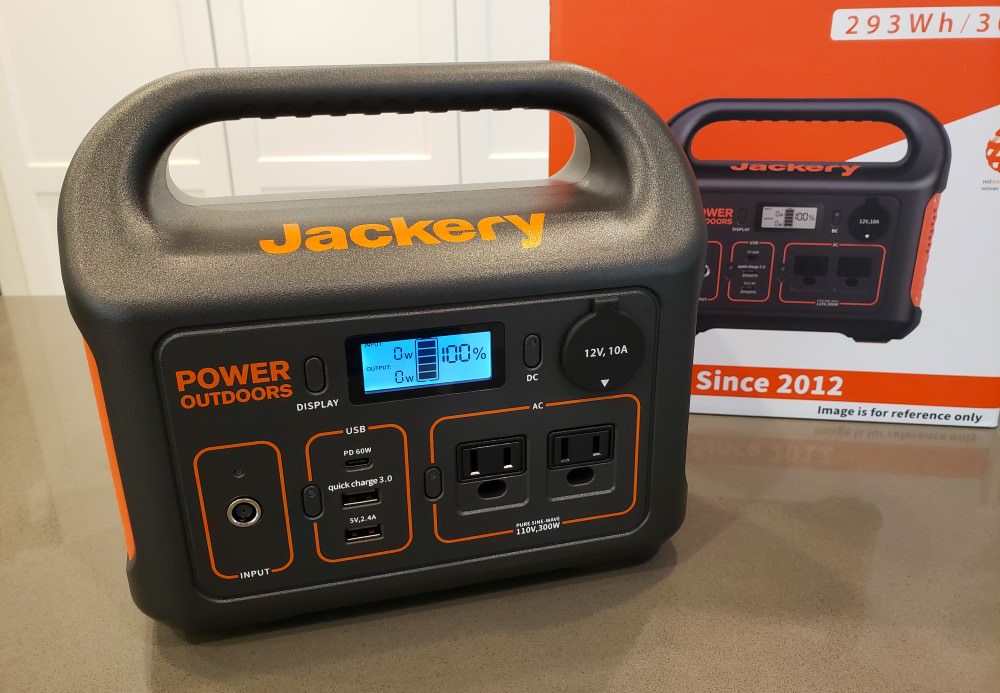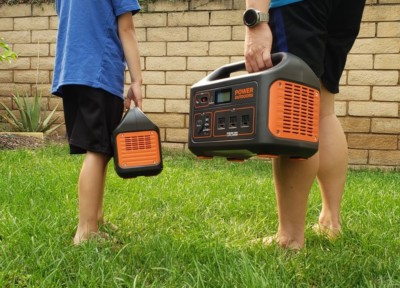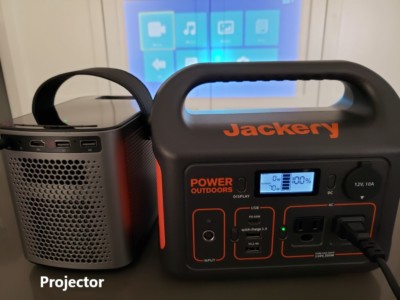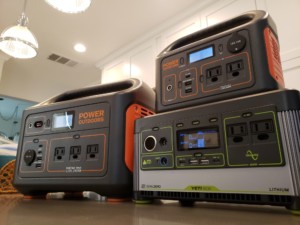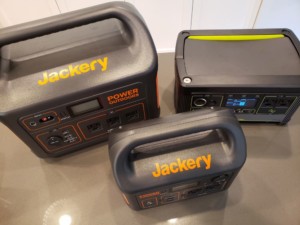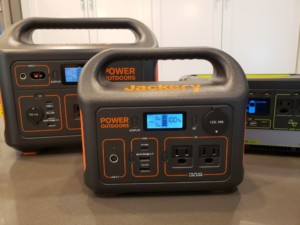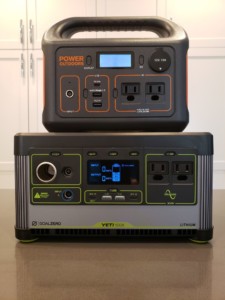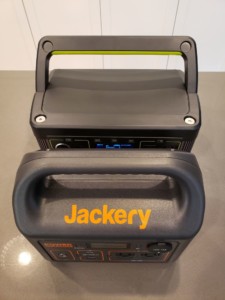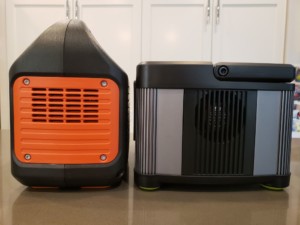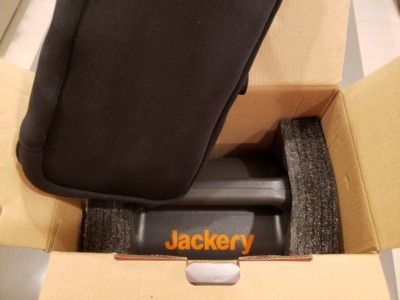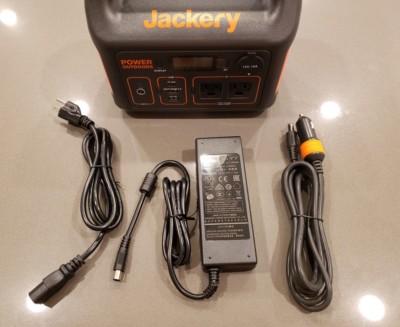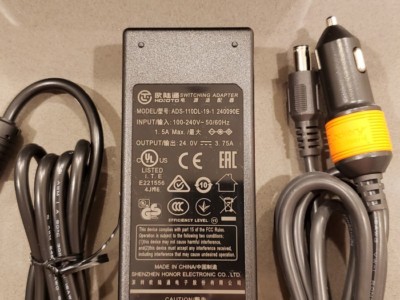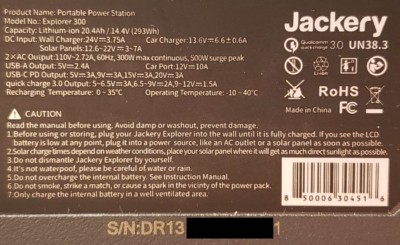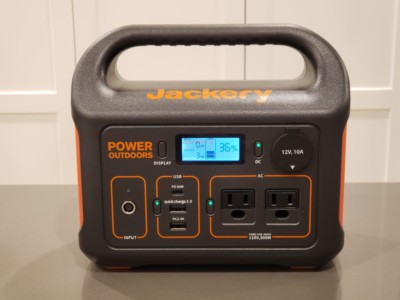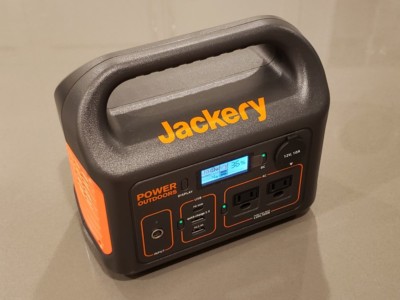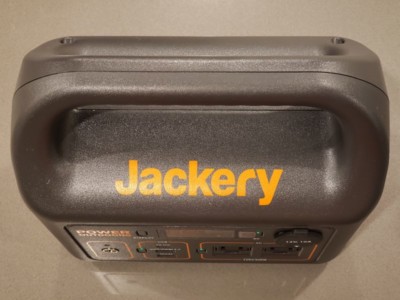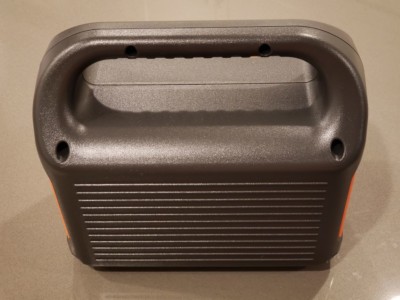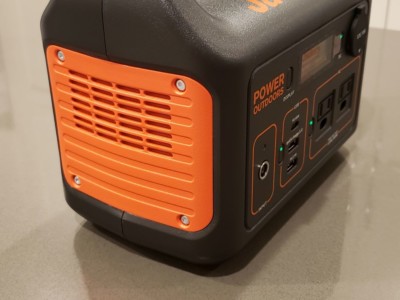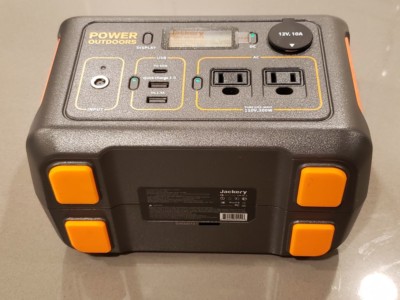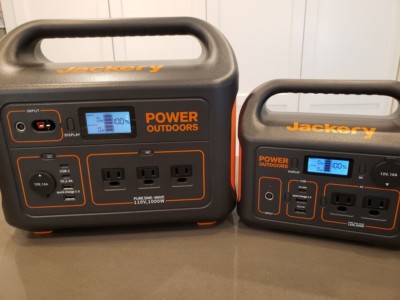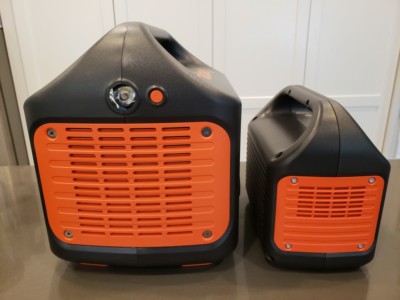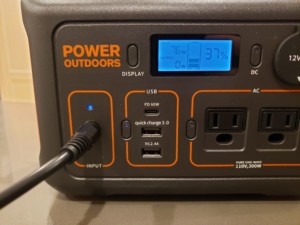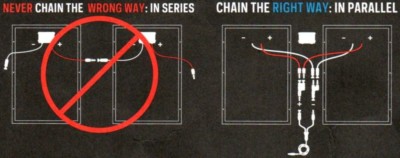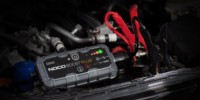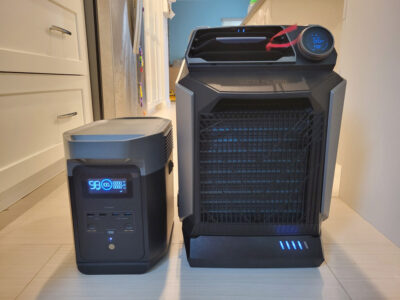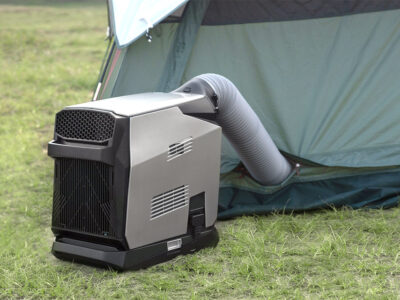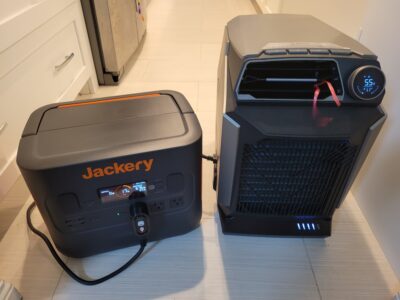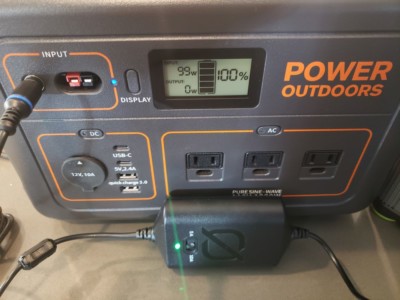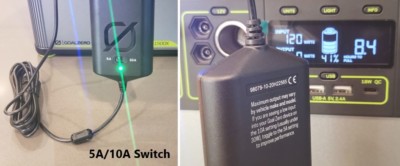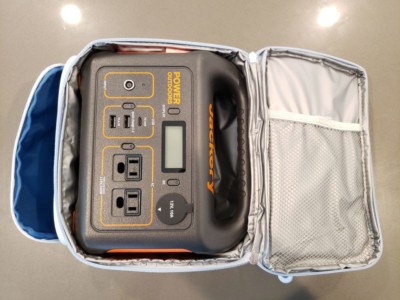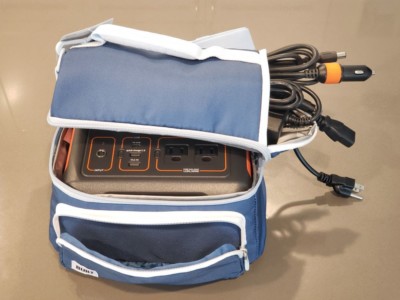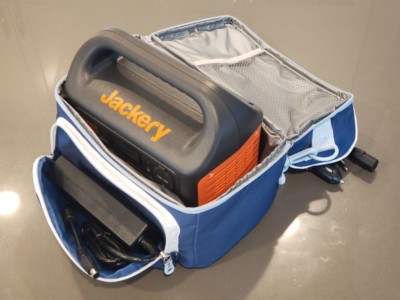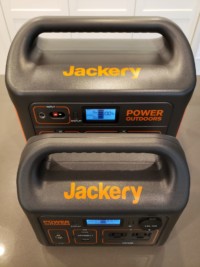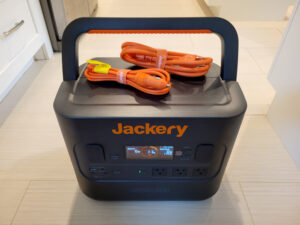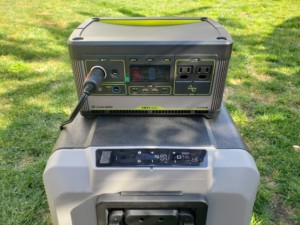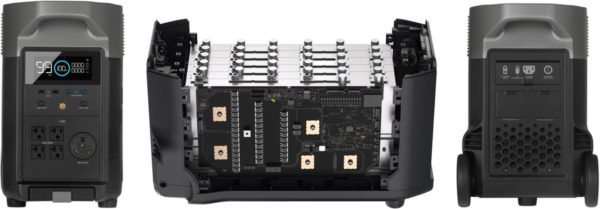Jackery Explorer 300
Contents
Explorer’s Little Sibling
Back in April, I purchased the Jackery Explorer 1000 and the Goal Zero Yeti 500x later as a result of 2019’s fires. Coincidentally, this year’s fires on the entire US west coast is actually WORSE with new records broken! I cannot stress how important it is to be prepared for emergencies, and with a baby and young boy in our household, I wanted to ensure we have a crucial refrigerator running to store milk, medication, and whatever else we needed.
There has been an increase in people taking emergency preparation more seriously.
I had since invested in several car freezers (favorite is the Foho 34qt BCD-32) as part of my emergency toolset. When Jackery announced the Explorer 300 (E300) with a special launch price and some improvements over the Explorer 1000 (E1000), I jumped on it for one simple reason: my little boy loves camping, and I wanted him to have a mini-Explorer of his own (actually, I wanted another backup battery, but don’t tell him that.) Literally, the E300 is a mini version of the E1000, and it looks awfully cute to have my son and I stand next to one another holding our own Explorers!
Right off the bat, the two models are very similar to one another, and so I will be re-using much of what I had already written for the Explorer 1000. The E300 is the direct successor to the company’s Explorer 240 model.
The newly-released Jackery Explorer 300 is made by one of the — if not THE — best-selling companies on Amazon for the battery power station category. The company said it was formed by a former Apple battery engineer in 2012.
Jackery is a combination of “Jacket” and “Battery”. The company used to make Apple jacket batteries.
In A Nutshell
Jackery Explorer 300 is a relatively light power station with a professional-looking exterior and flashy, orange color scheme, and is backed by a company that appears, from the stories I have read (and personally experienced), to take customer service seriously. The batteries are made by a manufacturer I do not know much about, but their weight is an indicator that they are likely good quality. The 300W of energy (and peak of 500W) provides enough power for a small amount of electronics and small appliances, such as a laptop, television, mini fridge, medical device (like CPAP), and car freezers, but will NOT work for most rice cookers, and definitely not for a vacuum, water boiler, or circular saw.
Like the bigger Explorer 1000, the hard, plastic material used to help shed weight (and cost) could be prone to cracking from hard falls or bumps, potentially exposing the Lithium-Ion batteries to puncturing. The fixed carry handle unfortunately cannot be folded, making it not ideal for packing things on top.
Functionally, this is an excellent, portable power station with a multitude of AC and DC outputs, is solar charging capable with MPPT built in, and has a battery management system (BMS) to help ensure safety. Equally important is its verified claim of a pure sine wave – not modified – AC Inverter to produce clean electricity for sensitive electronics. Like Goal Zero Yeti 500x, Jackery finally upgraded the E300 with a USB-C PD with a 60W output. The E1000 only produces 18W. This makes it very useful for charging supported laptops.
Jackery is one of Amazon’s top sellers in the portable power station category with good customer service and reasonable prices, and as this is no longer my first experience with their products, I have no hesitation to recommend its latest product.
Goal Zero vs Jackery: Yeti 1000 Core vs 1000X vs Explorer 1000
Tip: A battery power station like this one cannot be used to jump start a car. Instead, I suggest getting a small, portable one specifically made for that, such as my favorite: NOCO Genius Boost Car Jump Starter (Lithium Battery).
Update: Jackery announced on 1/28/2021 that the updated Explorer 300 can now be charged through the 60W USB-C PD and be used in parallel with the 90W AC wall charger. This provides for a combined input of 150W, nearly cutting the charging time in half!
What’s Good? What’s Bad?
Pros
- At 293 Wh capacity, it is an improvement over its Explorer 240 model and falls in-between Goal Zero’s Yeti 200x and 500x capacities
- Capacity to power a 30″ LCD monitor and Mini PC for 3-5 hours, a Toshiba 50″ Fire TV for almost 2.5 hours
- Pure Sine Wave AC Inverter capable of continuous 300W power (and 500W peak) — More details later
- Jackery Explorer 1000 offers continuous 1,000W power with a peak of 2,000W
- Very well-priced at $349 at launch
- Can power AC and DC (USB/12V Car adapter) at the same time (as long as they draw less than 300W combined)
- Laptop, tablet, phones, lights, fans, CPAP medical device, projector, TV, mini refrigerator, speaker, camera, DSLR battery charger, and SOME rice cookers
- Faster charging with MPPT controller (Maximum Power Point Tracking)
- Can be used while charging
- Informative LCD with LED backlight
- Total power coming in (via solar panel or AC adapter)
- Capacity left (as a percentage)
- Total power (AC and DC combined) being used
- Suaoki G500 displays the Wattage separately for DC and AC, which I prefer
- Unfortunately, estimated hours to full charge or empty is NOT shown
- High-quality BMS (Battery Management System) for safety
- Provides built-in overload, overcharge (automatic stop when the device is full), and short-circuit protection
- VERY compact at 9.1″ x 5.2″ x 7.8″, though the higher-capacity, slightly larger Goal Zero Yeti 500x is still my favorite for its size and capacity
- Portable at just 7.1 lbs
- USB-C PD port outputs 60W (Explorer 1000 only provides 18W)
Update: Jackery announced on 1/28/2021 that the updated Explorer 300 can now be charged through the 60W USB-C PD and be used in parallel with the 90W AC wall charger. This provides for a combined input of 150W, nearly cutting the charging time in half!
- Bottom is well-protected by bright-orange, non-slip feet
- Carry pouch included to hold AC charger and cables
- Cigarette socket cable included
- Unexpectedly good customer service
- Technical support was excellent in answering all my questions
- 2 year warranty
- Manual: Clear and well-written, though details were scarce
- Goal Zero’s manual, on the other hand, is VERY detailed and helpful
- Company is based in California
Cons
The E300 shares almost all the same design problems I disliked about the E1000, but also adds some improvements.
- Batteries are not made by a globally well-known, Tier 1 manufacturer
- My unit came with fuel cells by EVE Battery, a China-based, publicly-traded company
- No Anderson input port for solar charging like the Explorer 1000
- You charge with an (optional) Anderson-to-8mm converter cable instead
- Fixed carry handle cannot be stowed away
- Makes it difficult to stow things on top at the back of a trunk
- Upward-curved top (underneath the carry handle) does not allow small items to be temporarily stored on top
- Hard, plastic material makes the power station lighter, but could be prone to cracking from hard falls or bumps
- Given that Lithium-Ion batteries become more volatile as capacity increases, one should handle the product with care
- Although the exterior looks very professional, once I saw the Goal Zero Yeti 500x, I fell in love with the Yeti’s design
- Power buttons can be accidentally turned on/off through a single press (ie. while packing away your camping gear)
- Can lead to accidentally turning on/off the output during transport
- May unexpectedly find battery fully drained when you need it
- Suaoki requires you to hold the DC or AC button for 2 seconds before it turns on/off that output, helping to minimize accidental presses
- No automatic power off once no power is drawn/station has become idle
- AC power brick is flat and large
- No built-in light (like the Explorer 1000) to illuminate your walking path (or area) or blink “S.O.S.”, the international distress signal
- Display is not as informative as I’d like
- Only shows battery charge level, input and output wattage, but no estimate of time remaining to full charge or to empty
- Multiple fans turn on during high peak and can be too noisy for some
- Battery cannot be replaced. This can lead to unnecessary landfill waste
- Cannot be daisy-chained to other Explorer 300/1000’s to extend battery capacity
- Some Goal Zero stations can be hooked up to other ones so power can be provided for an even longer time without needing to switch
- Not waterproof. Keep it away from water splashes, rain, and pool!
- Lithium and fire or water can cause serious damage or injury!
- No master power off button to turn off ALL outputs at the same time
- You have to manually switch off each type: DC, AC
- No carry bag for the power station itself is included
Ports
Input
- (1) 8mm
- Accepts up to 90W
- Max 12-30V and 10A with no minimum wattage
- WARNING: Do NOT use a power source/solar panel that exceeds 30V or 10A!
- Be mindful that solar panels that are daisy chained may output more than 30V combined!
- WARNING: Do NOT use a power source/solar panel that exceeds 30V or 10A!
- Can be used for solar charging
- MPPT charge controller is built in
- I recommend using a panel that’s between 30W – 100W at 18V (with the right Amps to equal 100W)
- If you attach a 120W solar panel (with 12V x 10A = 120W), it will charge at only 90W
- I did not test solar charging as California is currently blanketed by smoke from the massive fires all over the west coast
- Jackery SolarSaga 100W charged the Explorer 1000 at an excellent 69-88W of input. I expect it to be similar with the E300
- Use of multiple solar panels
- WARNING: Do NOT daisy-chain them in sequence/series as that can output more than 30V combined!
- Connect them in PARALLEL instead with a Y branch cable (not included)
- (1) USB-C PD
- Jackery announced on 1/28/2021 that the updated Explorer 300 can now be charged through the 60W USB-C PD and be used in parallel with the 90W AC wall charger. This provides for a combined input of 150W, nearly cutting the charging time in half!
Output
- (2) AC with 3 prongs (120V)
- Inverter can handle a continuous 300W, peaking at 500W. More on that later
- Pure Sine Wave Inverter
- Ensures clean power to protect against damage to sensitive electronics
- Generates less heat
- Note: Some manufacturers claim to be Pure-Sine when they are actually Modified or Square Waves
- (1) Cigarette socket (12V, max 10A)
- (1) USB-C PD (5-20V, max 3A, max PD 60W)
- PD (Power Delivery) allows a device to be charged with up to 60W through the USB-C interface
- (2) USB-A (5V, max 2.4A, max 12W)
- One of them is a QuickCharge 3.0 for rapid charging of compatible devices
Usage
- To turn ON or OFF the DC (12V Car, USB) or AC outputs, press the corresponding button (“DC”, “USB”, “AC”)
- Note: This single-press (without hold) can lead to accidentally turning on or off the power station
- To reset an Error condition that’s shown on the LCD (ie. AC port is Overloaded), turn OFF the respective AC or DC output, and back on
- To reset the Explorer, hold the DISPLAY button for 10 seconds
- Li-ion NMC batteries have 500 charge cycles before capacity drops to about 80% from when they were new
- Product could, in theory, be charged up to 2,000 cycles — about 1/4 of total capacity is lost every 500 cycle
- Unlike LiFePO4 batteries, NMC can operate only in temperatures between 32-104F (0-40C). Both are Lithium-ion chemistries
- Jackery’s Battery Management System (BMS) prevents:
- Recharging in temps outside of 32 – 95F (0 – 35C)
- Outputting power in temps outside of 14 – 104F (-10 – 40C)
- Jackery’s Battery Management System (BMS) prevents:
- Battery, like all Li-ion, slowly drains over time even when station is powered off
- Could take 1-1.5 years to go from full to empty
Continuous vs Peak Output
- Explorer 300’s AC Inverter provides a continuous output of 300W with a peak/surge of 500W
- AC Inverter: Component responsible for converting battery (DC) power into AC for use by electronics
- Continuous Output: As long as a device (or combination of multiple ones) does not exceed 300W, it can be used
- A TV that uses 100W can be used because it is less than 300W. You can add more devices as long as they do not exceed 300W combined
- A miter saw I have uses 1,800W, and because it exceeds 300W, it cannot be used
- Peak/Surge: Almost every device temporarily draws more power when it is turned on. The highest amount it pulls during that time is the Peak/Surge. This Explorer can accept up to 500W
- A TV that uses 200W (continuous) may temporarily suck up 400W (peak) when powered on. Because 400W is less than 500W (peak), this battery will allow the TV to turn on at that level for a few seconds (any longer, and it might cut power as a safety precaution). After a few seconds, the TV then only uses 200W (less than the continuous 300W limit) until the battery is drained
- An unusual device that uses 250W (continuous) and surges to 1,500W when powered on would instantly be shut off by the Jackery. Why? Even though the device uses just 250W while already on, it jumps to 1,500W when powered on, exceeding the 500W surge limit of the Jackery
Most devices power on at a higher (Peak) wattage than when they are already on (Continuous). Therefore, if its peak exceeds the power station’s max, it may not be able to start
Calculations – Size & Time
What size battery should you get? How long will it power your fridge for? How long will it take to recharge? The below calculations can help answer those questions and are rough ESTIMATES as conditions, battery quality, and age can vary.
Time to Charge Battery
- Wall charger: 4-5 hours
- 90W AC adapter was observed to provide 76W when charging level was at 37%
- AC adapter will gradually charge slower as battery reaches full capacity (for safety reasons)
- Goal Zero 12V Car Charger (Goal Zero/Amazon)
- 60W @ 4-5 hrs (5A setting) / 90W @ 3-3.5 hrs (10A setting, if car supports it) (Note: GZ charger can go up to 120W, but Explorer 300 can only accept up to 90W)
- Most other manufacturers only charge up to 60W. So, 120W with the Goal Zero is game-changing for me and comes highly recommended
- Goal Zero Yeti 500x can combine its 8mm and USB-C PD ports for a total input of 180W. Neither the E300 nor E1000 can combine both inputs
Update: Jackery announced on 1/28/2021 that the updated Explorer 300 can now be charged through the 60W USB-C PD and be used in parallel with the 90W AC wall charger. This provides for a combined input of 150W, nearly cutting the charging time in half!
Charge Time with Solar
- Calc: Hours to charge battery = Battery capacity (Wh) / (Panel Wattage x [0.5 or 0.75])
- In a perfect lab environment, solar panels charge at the indicated wattage (ie. 150W)
- Expect to only receive 50-75% on a good, sunny day (ie. 75W – 113W), depending on environmental conditions, panel’s age, and component quality
- 100W solar panel: as fast as 3.9 hours [293 Wh / (100W x 0.75)] to charge
- Tips
- Keep charging even when overcast as the panels will STILL collect energy
- Underproduction: If a 100W panel is not making enough (ie. only 50W) due to bad conditions, adding an extra one can generate a higher, combined output (ie. 50W + 50W from the two panels = 100W total)
- Overproduction: If the panels make more (ie. 200W) than the maximum the power station charge port can take, only the max the power station can take will go through
- WARNING: do NOT connect panels sequentially or you may output too much voltage and fry the power station! Connect them in PARALLEL with a Y-Branch cable
Watts Used/Produced
- Calc: Watts used or produced by device = Voltage x Amperage
- Vacuum with 120V @ 9.5A uses 1,140W
- Solar panel with 12V @ 10A can produce up to 120W
If a device draws more than 300W for an extended period of time, the power station will shut off as a safety precaution. This can also shorten the battery’s lifetime
Ideal Battery Size
- Calc: Battery capacity (Wh) = Watts used by device x Hours needed for / 0.85
- 10-15% of power is lost during power conversion
- 45W car fridge needed for 8 hours: Minimum 424Wh power station (45W x 8 / 0.85)
How much energy a battery can store is measured in Wh (Watt-hours), and how much power is used or produced in W (Watts).
Time Before Battery is Empty
- Calc: Hours available for device = Battery capacity (Wh) x 0.85 / Watts used by device
- 10-15% of power is lost during power conversion
- 60W laptop with 505Wh battery: Up to 7.2 hours (505Wh x 0.85 / 60W)
Time to Charge Device
- Calc: Hours to charge device = Device’s battery capacity (Wh) / Input Wattage
- 60W laptop with 200Wh battery: Up to 3.4 hrs (200 Wh / 60W)
Conversion to mAh
- Calc: Powerbank-equivalent capacity (mAh) = Battery capacity (Wh) / Voltage x 1000
- 1 Ah = 1000 mAh
- Explorer’s 293Wh @ 3.6V = 81,389 mAh powerbank (293 Wh / 3.6V x 1000) or 27,129 mAh @ 10.8V
Tips
- Always test your devices with the power station before you depend on it on the go
- Lithium-ion batteries are volatile
- To minimize fire damage to your belongings or loved ones, store the power station in the garage and not inside the house. Best storage is a dry, cool place, however
- You cannot bring a battery of this capacity on a plane
- With the right BMS, quality batteries, and other factors, the power station can be stored in the car while camping during a hot, California summer
- Keep the battery out of direct sunlight. I usually store it on the floor of the car and crack open the windows a tiny bit
- Do not USE in the car if temperatures fall below or exceed the battery’s rated, operating temperature (32-104F or 0-40C)
Keep your car cigarette lighter with the power station — you could plug it into its 12V DC socket for starting a camp fire
 If using a car charger, make SURE you only charge this station while the car is RUNNING. Otherwise, you’ll deplete your car’s battery and leave you stranded
If using a car charger, make SURE you only charge this station while the car is RUNNING. Otherwise, you’ll deplete your car’s battery and leave you stranded- If charging with a solar panel, be sure to keep the station out of direct sunlight as it could overheat
- A solar panel is NOT required to use the battery
- Explorer 300 uses the MPPT solar charge controller/regulator
- Smarter, more efficient and expensive than PWM (Pulse Width Modulation)
- Suitable for larger systems
- Can be used and charged at the same time. Manufacturers’ recommendations for their own products:
- Yes, that’s fine: Goal Zero, Jackery, Rockpals, nrgGo
- No/Not advisable: Suaoki
- NEVER charge the power station itself in below freezing temperatures, or you will damage the Li-ion battery AND potentially limit its overall capacity
- You CAN use it to power OTHER devices because the generated heat will warm its battery enough to be within operating temps
- At below freezing temps, keep it in an insulated cooler and connected to a power source (ie. solar panels). The heat generated by the battery will keep it running as best as it can
- Turn off any output ports (AC/DC) that are not being used in order to conserve power
- Without anything plugged in, the AC inverter still draws 7W on its own
- Do not use any power station in a tightly enclosed area as it can overheat
- BUILT Willis 11″ Insulated Lunch Box fits the E300 perfectly well (with usable pockets) when the Jackery is put on its side
- If charging the station with the car socket, you cannot get it to 100% capacity with a 12V outlet. If you have a 24V outlet, however, you could
- To prolong the battery lifetime while in storage, keep the battery fully charged every 3-6 months
- Or, according to customer support, keep it plugged in when not in use and discharge it to 50% every 3-4 months
- The charging controller automatically gets disabled once the batteries are full
- NOT using the battery for a very long time can actually hurt its lifetime
- There is no “memory effect” in this station’s battery
- Note: It is better to NOT let it completely drain before recharging
- The battery is NOT replaceable, although some of Goal Zero’s products are
- Or, according to customer support, keep it plugged in when not in use and discharge it to 50% every 3-4 months
CAUTION: Lithium-ion batteries do NOT like to remain discharged at 0% for prolonged periods of time. If you let your battery stay at 0% for too long, you may not be able to charge it again without specialized equipment.
Jump Start Car?
A battery power station like this one cannot be used to jump start a car. Instead, I suggest getting a small, portable one specifically made for that, such as my favorite: NOCO Genius Boost Car Jump Starter (Lithium Battery).
Portable Air Conditioner
The EcoFlow Wave is a portable air conditioner that accepts both AC and DC input. The company, of course, recommends using its own Delta power stations for better efficiency and longer runtime because they can draw directly from DC power. In a pinch, any battery or generator capable of providing the Wave-required input wattage could be used, but keep in mind that AC power loses some energy due to conversion to DC.
Goal Zero 12V Car Charger
I wanted to point out how GAME-CHANGING the Goal Zero 12V Car Charger is (Buy on Goal Zero/Amazon). The company inexplicably does not promote its benefits enough, but it can be used to charge batteries at a whopping 120W when the car port supports 10A (like my Toyota Sienna and Highlander did!) All other car chargers I have (Jackery, Rockpals, Paxcess) only go up to 60W, but the Goal Zero can double that! What does that mean? Faster charging while driving around town! I bought two — one for use with the Yeti 1500x and another with the Jackery Explorer 1000.
The Goal Zero 12V Car Charger can charge a supported Goal Zero, Jackery, Bluetti, or EcoFlow battery at a whopping 120W! The Explorer 300 will only charge at up to 90W, however, but that is still better than 60W with its own car charger.
BUILT Willis 11″ Carry Bag
A great alternative to the official, Jackery Explorer 240/300 carry bag is the insulated lunch box by BUILT Willis. It fits the Jackery Explorer 300 perfectly well when it is placed on its side, leaving plenty of space and pockets open to store charging cables and accessories.
If the Explorer 300 is stood vertically in the lunch box, the fit is extremely tight. Lay the power station on its back instead.
Final Thoughts
The Explorer 300 is another winner for Jackery in that it has made several improvements over its older, bigger brother, the Explorer 1000. I was disappointed to find out that its batteries are made by EVE Battery, a Chinese, publicly-traded company I have little knowledge of. The Explorer 1000, on the other hand, used either LG or China-based BAK Battery, both of which are excellent manufacturers. The company has shown time and time again that it takes customer service VERY seriously, and to me, that is a major plus. The 300W of energy (and peak of 500W) provides enough power for a small amount of electronics and small appliances, and is the perfect size for my little boy, the fellow explorer and camper.
The hard, plastic material commonly used by power stations to help shed weight and cost (just like the E1000) could be prone to cracking from hard falls or bumps, and as such, this product should be handled with care – a puncture of the Lithium-Ion batteries could cause severe harm. The fixed carry handle unfortunately cannot be folded, making it more difficult to pack things on top.
Jackery is one of Amazon’s top sellers in the portable power station category with good customer service and reasonable prices, and if the new EVE Battery manufacturer proves to be as reliable as other Tier 1 makers (like LG or Panasonic), I will have no hesitation to recommend the Explorer 300.
Goal Zero vs Jackery: Yeti 1000 Core vs 1000X vs Explorer 1000
Where To Buy
- Jackery Explorer: Battery power stations with solar charging capability
- Jackery SolarSaga: Solar panels
Related Posts
- Power Generators: Gas vs Propane vs Battery Station (and Solar)
- Ultimate Reference: Power Station Comparison
- EcoFlow Wave Portable Air Conditioner
- Reviews
- Goal Zero vs Jackery: Yeti 1000 Core vs 1000X vs Explorer 1000
- Goal Zero Yeti 1500x / Yeti 1000x / Yeti 500x
- Jackery Explorer 2000 Pro / Explorer 1000
- EcoFlow Delta Pro LiFePO4
- Bluetti EB70S LiFePO4
- BigBlue Cellpowa500 LiFePO4
- Rockpals 500W / nrgGo 400
- Quick Look
- Announcements
Other Useful Topics
Power Station Comparison
Check it out!
Ultimate Reference: Power Station Comparison – We summarized the specifications of many of the power stations we had come across or reviewed all in one place.
Gas/Propane Generators vs Battery Power Stations
In July 2020, I wrote about this topic after many asked what their differences were. In short, gas/propane generators can run virtually forever but are loud, dirty, and potentially quite dangerous. Battery power stations, on the other hand, are more portable, silent, less volatile, and can be operated indoor, but depend on external power (like solar) to recharge. Where gas/propane are used to GENERATE electricity, batteries STORE them for later use. Personally, I am a fan of the latter because they are so easy to carry around and are safer to use.
Who is Jackery?
According to the company, its name was derived from “Jacket” and “Battery” as a homage to its Apple jacket battery manufacturing roots. The company was founded in 2012 by a former Apple battery engineer and claims to have “launched the [World’s] first… Lithium Portable Power Station” three years later. It had partnered with Honda to brand the Japanese namesake onto a variety of battery products.
Battery Technology and Safety
Goal Zero debuted with Lead-Acid batteries that were bulky and heavy. Today’s devices use Lithium-ion — commonly Nickel Manganese Cobalt (NCM) or Lithium Iron Phosphate (LiFePO4 / LFP) chemistries — for more power in a smaller, lighter package. NMC, however, is more volatile than LiFePO4 and becomes riskier as more cells are packed together. Goal Zero and Jackery used NMC for some time whereas EcoFlow and Bluetti use LiFePO4. Jackery launched its first LiFePO4 model in mid-June 2023 and Goal Zero in October that year.
- How much energy a battery can store is measured in Wh (Watt-hours), and how much power is used or produced in W (Watts)
- The higher the Watt-hour (Wh) capacity rating, the more dangerous the battery could become if not handled right
The quality of the battery cells and the BMS (Battery Management System) are crucial for safety.
Cell Manufacturers
Battery cells made by LG and Sony are among the best in the hobbyist world as are Sanyo/Panasonic and Samsung. Goal Zero uses LG. Jackery also uses LG or BAK (a leading Chinese brand). EcoFlow makes its own. During my years of research, I found that use of lower-quality batteries could pose a serious risk to life and property and should become a crucial part in deciding what to buy.
Safety
The second part in a battery’s safe operation depends heavily on the design and BMS (Battery Management System). Some BMS manufacturers, unfortunately, overstate their capabilities that could lead to catastrophic failure.
- Design should allow for proper, thermal cooling, use quality components, and obtain proper certifications
- Batteries made by known manufacturers are less likely to fail
- BMS should sufficiently restrict the battery from going past its capabilities
Li-ion: LiFePO4 vs NMC
There had been a lot of debate over whether Nickel Manganese Cobalt (NMC) or Lithium Iron Phosphate (LiFePO4) was better. Both are Lithium-ion batteries. Goal Zero, Jackery, and most of today’s power station manufacturers use NMC, but why do EcoFlow and Bluetti use LiFePO4 when they are bulkier and heavier? There are important distinctions, but the best battery is the one that meets all or most of your unique needs.
Charge Cycles
One of the most significant differences — and buying factors — is the charge cycle count for both battery chemistries. It measures how long the battery can be used for before it must be replaced or thrown away. LiFePO4’s count is as high as 4,000 cycles (as of 2023) whereas NMC is 500+. However, both have a useful life that can range between 3,000 – 5,000 cycles (even as much as 7,000 with proper care). But how does the count determine longevity?
Let’s look at Li-ion NMC as an example. It loses about 20-25% of total capacity after every 500 charge cycle. That means after the first 500 cycles, the battery drops 20% from when it was new, then another 20% after the next 500 cycles, and 20% again after that one. It would take roughly 1,500 charging cycles to have the battery last only half as long as when it was brand-new. Thus, it should be usable for 2,000+ cycles or about 6-10 years. Li-ion LiFePO4 can last longer.
CAUTION: Lithium-ion (LiFePO4 and NMC) batteries do NOT like to remain discharged at 0% for prolonged periods of time. If you let your battery stay at 0% for too long, you may not be able to charge it again without specialized equipment. Keep them at between 20-80% while in storage to maximize their lifetime.
LiFePO4 Advantages
- Safer, less volatile, and thus cheaper to manufacture
- Higher charge cycle: 1500-2000 (10+ years). NMC: 500+ (6-10 years)
- Usable in more extreme temperatures (-4F/-20C to 176F/80C). NMC: only 140F/60C max
- Holds 350-day charge. NMC: 300
NMC Advantages
- Smaller and lighter. Allows for more portable products
- Faster charging

